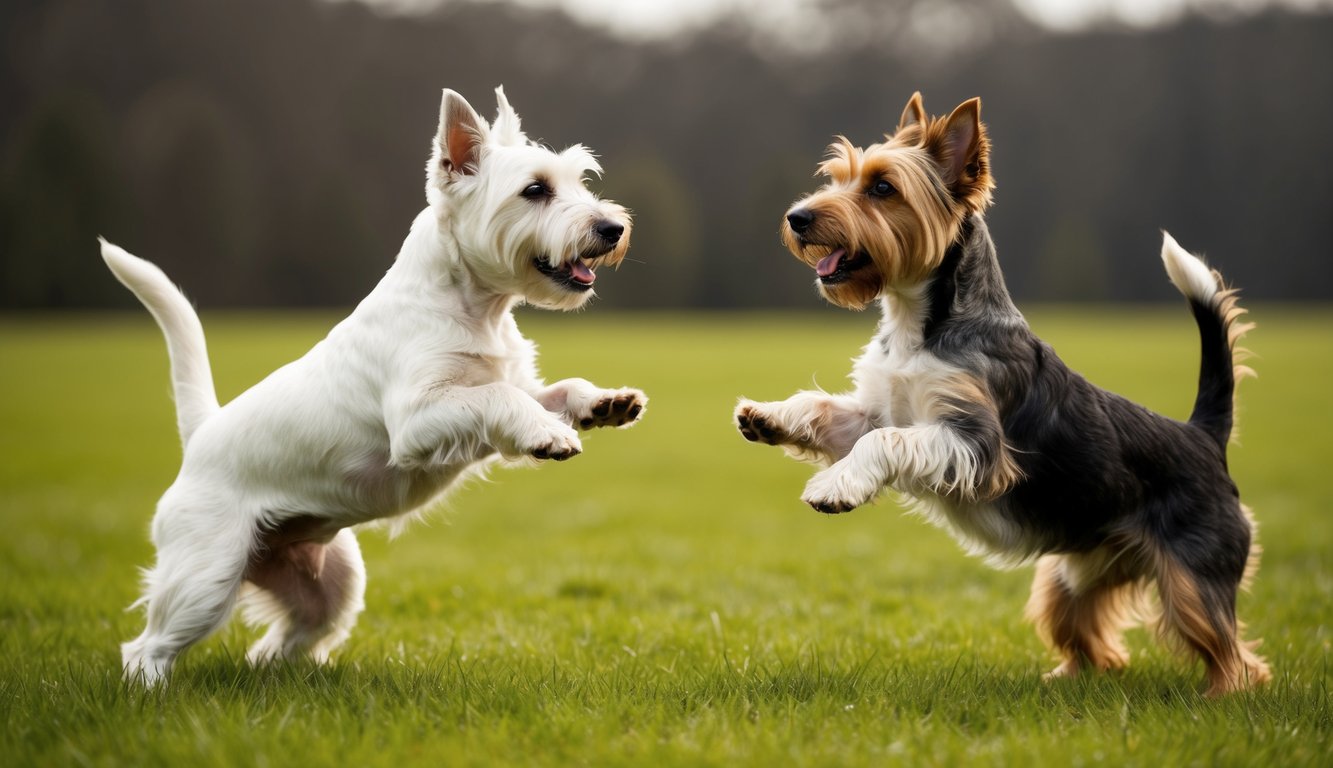The West Highland White Terrier and Cairn Terrier are Scottish breeds with distinct traits. Both have rich histories and unique characteristics that set them apart from other terriers. Let’s explore the similarities and differences between these two breeds.
If you’re still on the market to buy a Westie or Cairn Terrier, PuppySpot currently offers a $300 discount using the code PUPPY300, just click the banner below!
Physical Attributes
West Highland White Terriers and Cairn Terriers have distinct physical traits that set them apart. These small Scottish breeds share some similarities but differ in key areas like size, coat, and coloration.
Appearance Comparison
- West Highland White Terriers have a compact, sturdy build with a rounded head and erect ears. Their eyes are dark and almond-shaped, giving them an alert expression.
- Cairn Terriers have a similar build but with a more fox-like face. They have a broader skull and shorter muzzle compared to Westies.
- Both breeds have strong legs and deep chests. Their tails are typically carried high and can be straight or slightly curved.
Coat and Color
- The coat is a key distinguishing feature between these breeds. West Highland White Terriers have a pure white double coat. Their outer coat is harsh and straight, while the undercoat is soft and dense.
- Cairn Terriers have a similar double coat texture, but they come in various colors. Their coats can be brindled, black, red, wheaten, grey, or sandy.
- Both breeds shed minimally but require regular grooming to maintain their coat health and appearance. Westies need more frequent brushing to keep their white coat clean and bright.
Personality and Temperament
West Highland White Terriers and Cairn Terriers have distinct personalities and temperaments. Both breeds are known for their lively and spunky attitudes, but there are some key differences in their behavior and social needs.
Behavioral Traits
- Westies are confident and independent dogs. They can be stubborn at times, but they’re also playful and enjoy attention from their owners. These dogs have a moderate energy level and need regular exercise to stay happy.
- Cairn Terriers are curious and alert. They love to explore their surroundings and can be quite adventurous. These dogs are known for their tenacity and may be more prone to digging or chasing small animals.
- Both breeds have strong prey drives due to their hunting backgrounds. They may need extra training to control these instincts around smaller pets.
Temperament Comparison
- Westies tend to be friendly and outgoing with people they know. They can be a bit reserved with strangers at first but warm up quickly. These dogs are generally good with children and other pets when socialized early.
- Cairn Terriers are often more independent and may be less cuddly than Westies. They have a bold personality and can be quite vocal. Cairns are usually good with kids but may be less tolerant of rough play.
- Both breeds are intelligent and can be trained, but they may have a stubborn streak. Positive reinforcement works best for both Westies and Cairns.
Socialization Needs
- Early socialization is crucial for both West Highland White Terriers and Cairn Terriers. This helps them develop into well-rounded adult dogs.
- Westies benefit from exposure to different people, animals, and environments. They’re generally social dogs but can become shy or anxious without proper socialization.
- Cairn Terriers need socialization to help manage their strong-willed nature. They should be introduced to various situations to prevent them from becoming overly territorial or aggressive.
- Both breeds do well with consistent training and positive experiences. Regular walks, playdates with other dogs, and visits to dog-friendly places can help meet their socialization needs.
Health and Longevity
West Highland White Terriers and Cairn Terriers are generally healthy breeds. Both face some similar health challenges, but there are also differences in their medical needs.
Common Health Issues
- Both breeds can develop hip dysplasia and patellar luxation. These conditions affect the joints and can cause discomfort or mobility issues. Regular vet check-ups help catch these problems early.
- Westies are prone to skin allergies. They may scratch excessively or develop rashes. Cairn Terriers often have fewer skin problems.
- Both breeds can suffer from eye issues. Glaucoma is a concern for Westies and Cairns alike. Regular eye exams are important to maintain good vision.
Special Health Considerations
- Westies may develop Legg-Calve-Perthes disease, a condition affecting the hip joint. This can lead to lameness if not treated promptly.
- Liver shunts are another concern for Westies. This condition affects blood flow through the liver and can cause various symptoms.
- Cairn Terriers may be more prone to dental issues. Regular teeth cleaning and check-ups are crucial for their oral health.
- Both breeds have similar lifespans, typically ranging from 12 to 15 years. Good care, proper nutrition, and regular vet visits can help these terriers live long, healthy lives.

Care and Maintenance
Both West Highland White Terriers and Cairn Terriers need regular care to stay healthy and happy. Their grooming, exercise, and diet needs differ slightly.
Grooming Needs
- West Highland White Terriers have a white double coat that needs frequent brushing. They should be brushed 2-3 times a week to prevent matting and tangling.
- Westies need professional grooming every 4-6 weeks. This keeps their coat looking neat and tidy.
- Cairn Terriers have a harsh outer coat with a soft undercoat. They need brushing 1-2 times a week to remove loose hair.
- Cairns should be hand-stripped every few months. This helps maintain their coat texture and color.
- Both breeds need regular nail trims, teeth cleaning, and ear checks. Bathing should be done only when necessary to avoid drying out their skin.
Exercise Requirements
- West Highland White Terriers and Cairn Terriers are energetic breeds. They need daily exercise to stay healthy and prevent boredom.
- Westies enjoy 30-60 minutes of exercise per day. This can include walks, playtime, or backyard romps.
- Cairns need similar exercise amounts. They love exploring and digging, so supervised outdoor time is ideal.
- Both breeds benefit from mental stimulation. Puzzle toys and training sessions help keep their minds sharp.
- Terriers have a strong prey drive. They should always be leashed or in a fenced area when outdoors.
Nutrition and Diet
- Proper nutrition is key for both West Highland White Terriers and Cairn Terriers. They need a balanced diet to maintain their health and energy levels.
- Feed these terriers high-quality dog food appropriate for their age, size, and activity level. Adult dogs typically need two meals per day.
- Portion control is important. These small breeds can easily become overweight. Follow feeding guidelines and adjust as needed.
- Treats should make up no more than 10% of their daily calorie intake. Use small, low-calorie treats for training.
- Some terriers may have food allergies. Watch for signs like itching or digestive issues. Consult a vet if problems arise.
- Fresh water should always be available. Clean and refill water bowls daily.
Training and Intelligence
West Highland White Terriers and Cairn Terriers are smart dogs with distinct training needs. They have different learning styles and require specific mental challenges to stay happy.
Trainability and Learning
- West Highland White Terriers are quick learners and respond well to positive reinforcement. They pick up commands easily but can be stubborn at times. Westies need consistent training to prevent them from becoming too independent.
- Cairn Terriers are also intelligent but can be more challenging to train. They have a strong-willed nature and may test their owners’ patience. Firm, consistent training works best for Cairns. Short, fun sessions keep them engaged.
- Both breeds benefit from early socialization and obedience training. This helps prevent behavioral issues as they grow older.
Mental Stimulation Needs
- Westies and Cairns are active, curious dogs that need regular mental stimulation. Without it, they may become bored and destructive.
- Puzzle toys and interactive games work well for both breeds. These activities challenge their minds and prevent boredom. Westies enjoy learning new tricks and excel in agility training.
- Cairn Terriers have a strong prey drive. They benefit from activities that let them use their hunting instincts safely. Scent work and hide-and-seek games are great options for Cairns.
- Both breeds need daily exercise and playtime to stay mentally fit. A mix of physical and mental activities keeps them happy and well-behaved.
Suitability as Pets
West Highland White Terriers and Cairn Terriers make great pets, but their suitability depends on your lifestyle and preferences. Both breeds are affectionate and energetic, with some key differences in their adaptability and social behaviors.
Adaptability to Lifestyle
- Westies and Cairn Terriers are small dogs that can adapt well to various living situations. They’re suitable for apartment living due to their compact size.
- Westies tend to be more adaptable and can handle changes in routine better. They have moderate energy levels and need regular exercise, but not excessively.
- Cairn Terriers are also adaptable but may be more energetic. They require more physical and mental stimulation to stay happy and healthy.
- Both breeds can experience separation anxiety if left alone for long periods. It’s important to train them early to be comfortable on their own.
Interaction with Family and Other Pets
Westies and Cairn Terriers are known for being affectionate family dogs. They form strong bonds with their owners and are generally good with children. Westies are often friendly and outgoing. They usually get along well with other pets if socialized early. However, they can be territorial and may chase smaller animals.
Cairn Terriers are typically more independent. They’re affectionate with family but may be reserved with strangers. They have a strong prey drive and might not be suitable for homes with small pets. Both breeds can be vocal, which is something to consider in apartment settings. Early training and socialization are crucial for both to ensure they become well-behaved family members.




